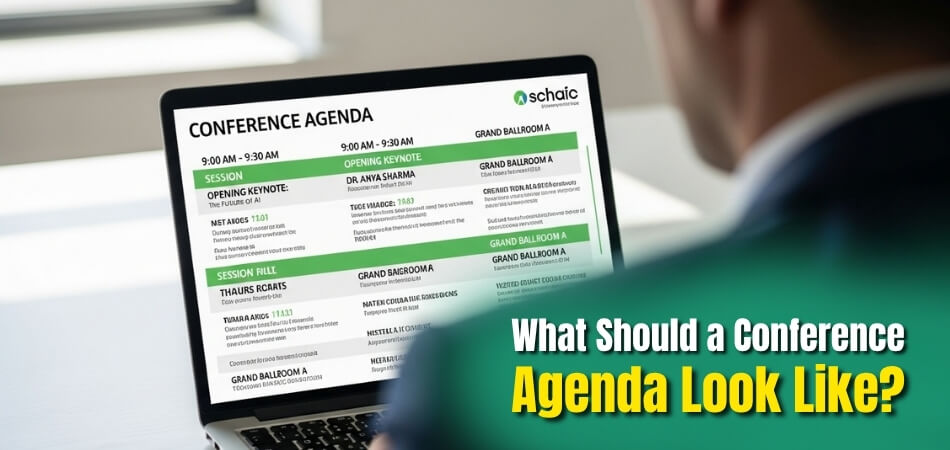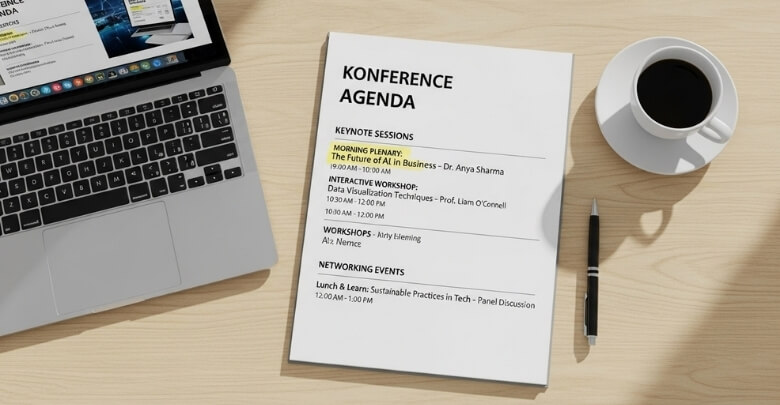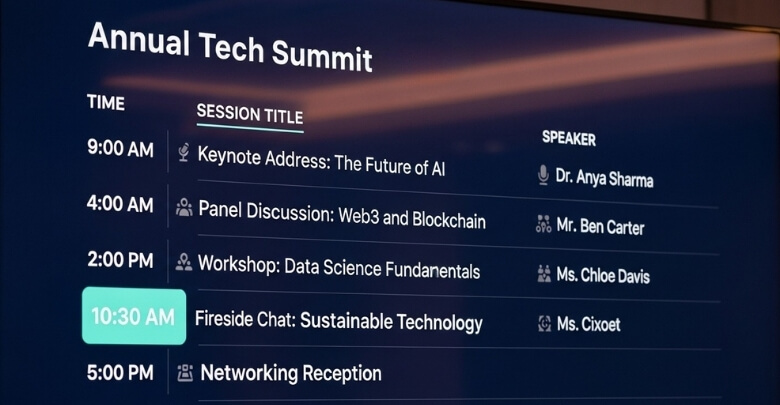Any conference’s agenda serves as its framework. It gives structure, helps everyone stay on track, and keeps things running smoothly from start to finish. Many people often wonder how to create one that looks clear and professional. You might also be thinking about what should a conference agenda look like?
A conference agenda should include event details, session titles, speaker info, and time slots. It must list breaks, meals, and networking sessions clearly. Add contact details, venue locations, and special notes. A clear agenda keeps the event organized and easy to follow.
Do you want to know more about building a clear and effective conference agenda? Keep reading because this article explains every important part you need to include for a well-organized and successful event.
What Should a Conference Agenda Look Like?
A conference agenda helps people know what to expect during the event. It shows the time, date, and location, along with details about sessions and speakers. It keeps everyone on track and avoids confusion. Read below to see how a good conference agenda should look and what it must include.
Basic Conference Information
Every agenda must begin with the main details of the event. This includes the title, the purpose, and the event dates. Add the starting and ending times clearly. Include the venue name and full address so people can find it easily.
Contact Information for Organizers
Clear contact details are very important, especially for big or international events like upcoming conferences in Canada, the USA, or any other country. Include phone numbers, email addresses, or help desk details. This makes it easy for attendees to ask questions or get help. Keeping this part simple makes the whole agenda more useful.
Session Titles and Descriptions
Each session should have a short, clear title and description. Explain what the session will cover and why it matters. Use simple words that make it easy to understand. This helps attendees choose sessions that match their interests.
Speaker Information
List all speakers with their names and short bios. Include their topic and speaking time. Adding a few lines about their background helps build interest. A good speaker list makes the event feel more professional.
Time Slots and Durations
Show the start and end times for every session. Include short breaks between sessions to give people time to rest. This keeps the event smooth and well-organized. It also helps attendees manage their time wisely.
Room or Venue Locations
Mention the specific room or hall for each activity. If the event has multiple areas, include a small map or clear labels. This avoids confusion and helps people move quickly between sessions. Clarity here makes a big difference.
Meal Times and Breaks
Plan and list all meal breaks in the schedule. Add time for breakfast, lunch, and dinner if they’re included. Also, include small refreshment breaks during the day. These moments help attendees relax and recharge.
Networking Opportunities
Set aside time for people to meet and connect. You can add morning or evening networking sessions. These times allow attendees to share ideas and make contacts. It’s a great way to build strong professional connections.
Special Events and Notes
Include extra events such as workshops, games, or evening programs. Add notes about transport, hotels, or nearby attractions. Small touches like this make the agenda more useful. It helps guests plan both learning and leisure.
A well-made agenda keeps a conference organized and easy to follow. It makes sure everyone knows when and where things happen. Always keep the details simple and clear for better understanding. Follow these tips to make your conference a success.
Why Is a Well-planned Conference Agenda important?
A good conference starts with a clear plan. The agenda works like a roadmap that guides everyone through the event. It helps both the organizers and the attendees stay on track. Let’s look at why having a well-planned conference agenda makes such a big difference.
Sets Expectations and Direction
A clear agenda tells people what will happen and when. It helps everyone understand where they need to be and at what time. When people know what to expect, they feel more comfortable and confident. This simple plan keeps things running smoothly and avoids last-minute confusion.
Keeps the Event on Schedule
An agenda works like a clock for the whole event. It helps each session start and end on time. This avoids long delays, awkward pauses, or overlapping sessions. A steady schedule makes everything move faster and helps keep the audience focused.
Helps Participants Prepare
When attendees can see the session list, they can plan ahead. They can pick which talks or workshops interest them most. This also helps them come prepared with questions or ideas. A little preparation leads to better discussions and more learning for everyone.
Improves Overall Experience
A conference feels better when it runs in order. Clear timing, short breaks, and smooth transitions make the event stress-free. It helps attendees relax, stay alert, and enjoy the day. A neat structure also makes the event look well-organized and professional.
Tool for Organizers and Staff
The agenda is not just for guests; it helps the whole team too. It tells speakers, staff, and volunteers exactly where they should be. This reduces mistakes and keeps everyone working together. A good plan helps the team handle surprises without trouble.
A good agenda is like the heart of a successful conference. It saves time, removes stress, and keeps everyone informed. Attendees know what’s happening, and organizers can manage better. Always plan your agenda carefully to make your event a smooth and enjoyable experience.
Key Elements That Every Conference Agenda Should Include
A conference agenda is the roadmap of the whole event. It tells people what is happening, when, and where. Here are the key elements every good conference agenda should include and why they matter.
- Title / Cover / Header: It shows the name, date, place, and theme of the conference so everyone instantly knows the event details and its main focus.
- Table of Contents / Overview: This helps people find sessions quickly, especially when the conference runs for many days or has different topics happening at the same time.
- Session Titles / Topics: Clear titles tell what each session is about, so participants can decide which ones they want to attend or skip.
- Speaker(s) Name(s): Mentioning who will speak gives credibility, helps attendees identify well-known names, and builds interest in the sessions.
- Time Slots: Showing start and end times for each session helps people plan their schedule better and avoid confusion or missed sessions.
- Location / Room / Track: Mentioning where each session takes place helps participants move easily between rooms or tracks without getting lost.
- Breaks / Lunch / Networking Times: Scheduled breaks let attendees rest, eat, and meet others, keeping them refreshed and engaged throughout the event.
- Transitions / Buffer Time: A few minutes between sessions helps with travel time, setting up equipment, or dealing with unexpected delays.
- Special Events / Keynotes / Panels: Highlighting major sessions ensures people don’t miss important talks or panels that make the event memorable.
- Logistics Info / Notes: Details like WiFi passwords, venue maps, and contact info help attendees manage practical needs easily during the conference.
- Sponsor Acknowledgments / Branding: Showing sponsor names or logos thanks supporters and helps strengthen professional relationships with them.
- Flexibility or Optional Tracks: Offering multiple session choices lets attendees pick what suits their interests and learning goals best.
Understanding the key parts of an agenda helps organizers plan sessions, speakers, and breaks in a way that keeps the event balanced and well-timed. A clear and complete agenda keeps everyone informed and on time. It reduces confusion, improves planning, and ensures both attendees and organizers enjoy a smooth and well-managed conference experience.
Common Mistakes to Avoid When Making a Conference Agenda
Planning a conference agenda can look easy, but it takes real care. Every small detail matters to keep things running smoothly and on time. A weak plan can confuse people and cause stress during the event. Keep reading to learn the most common mistakes and how to fix them the right way.
Unclear Session Timings
When the time for each session is not clear, it creates confusion. Attendees may miss sessions or arrive late to the next one. Always add clear start and end times for each part. Include a few minutes of buffer time between sessions for setup or short delays.
Missing or Too Few Breaks
Not giving enough breaks can make people tired and lose focus. Long back-to-back sessions also make them skip food or networking. Plan small breaks after heavy sessions or key panels. These pauses help attendees rest, eat, and connect better with others.
Overcrowded or Jammed Schedule
Packing every minute with sessions can make the day feel rushed. People need breathing space to move, talk, or relax a bit. Add short gaps between sessions and avoid squeezing in too much. Remember, quality time is better than quantity on your agenda.
Not Accounting for Room Changes or Walking Time
Switching between rooms can take longer than expected. If the timing is tight, sessions may start late and affect the flow. Check your venue map and measure walking time in advance. Leave extra time in the agenda for people to move between rooms easily.
Not Including Logistics or Notes
Leaving out basic info makes it hard for attendees to find what they need. Many forget to include WiFi info, contact details, or help desk notes. Always add a “Logistics / Notes” section with all key details. This keeps everyone informed and stress-free during the event.
Neglecting Multiple Tracks or Parallel Sessions
When several sessions run at once, people can get lost. Without clear labeling, they may attend the wrong track. Use colors, labels, or icons to mark each track. One common mistake is ignoring the conference agenda length, which can lead to rushed sessions or tired attendees.
Design or Layout Problems
Poor design can make a good agenda hard to read. Small text, messy layout, or weak contrast can confuse readers. Keep the layout clean with clear fonts and enough space. Make sure each session stands out visually so attendees can scan it fast.
No Flexibility or Backup
If a speaker cancels or a session runs long, you need backup plans. Without flexibility, the whole schedule may fall apart. Keep a few open slots or light activities for backup. Be ready to adjust and clearly inform attendees about any updates.
Publishing Late or Not Sharing in Advance
Releasing the agenda too late leaves attendees unprepared. They cannot plan their time or choose sessions ahead. Share both digital and print versions early. This gives people enough time to study the schedule and make good choices.
Creating a clear and smart agenda takes some time, but it’s worth it. Think about what your guests need and how to make things easy for them. A well-planned schedule helps every session run smoothly and keeps people happy. Follow these tips to build a simple, balanced, and successful conference plan.
How to Design a Conference Agenda That’s Easy to Read?
A well-planned agenda helps people follow the event without confusion. But even the best content can fail if the layout looks messy. Good design makes it simple for everyone to find what they need fast. Below are some easy ideas to help you make a clear and neat conference agenda.
Layout & Structure
Try using a clean table or column layout to keep everything in order. Place time, topic, speaker, and location in separate columns. Keep all text lined up in the same way so eyes move smoothly. Split the agenda into clear parts like morning, afternoon, and evening. It also helps to offer different views, like by time, track, or room.
Color, Contrast & Visual Cues
Pick colors that are easy to see and give enough contrast. Use bright bands or shades to mark different session types. Try adding small icons like a mic for talks or tools for workshops. This makes it easy to understand the session type at a glance. Simple borders or shaded boxes can also help separate sessions.
Font Size & Type
Choose easy-to-read fonts like Arial or Open Sans. Keep important things like session titles bold and slightly larger. Make sure the text size is big enough to read from a short distance. Avoid using too many styles, as it can look messy. Two or three font styles are enough to keep it clean and balanced.
Spacing & White Space
Leave enough space around text so it doesn’t feel crowded. Keep good gaps between lines and rows for clear reading. Try not to fill every inch of the page. Break long sentences or session details into short points or lines. Clean spacing helps the agenda look neat and calm.
Hierarchy & Emphasis
Use bold or dark text for session names and times. Use lighter or smaller text for extra details like speaker names or company info. Arrange information so the main parts come first. This helps readers quickly find the most useful details without getting lost in too much text.
Accessibility Considerations
Make sure colors and text are clear for everyone, even those with vision issues. Avoid red and green combinations that may blend together. Use simple and sharp fonts that stay readable on screens or print. If it’s a digital version, let people zoom in for better readability.
A clear and friendly agenda makes any event easier to follow. Design with simple layout, colors, and fonts that guide the eye naturally. Add space and balance so nothing feels tight or cluttered. Keep the look clean and let your agenda speak for itself with simple, smart design choices.
FAQs About What Should a Conference Agenda Look Like?
Here are some common questions people ask about creating a good conference agenda. These answers will help you understand what makes an agenda clear, easy to follow, and helpful for both attendees and organizers throughout the event.
How Can I Make a Conference Agenda Easy to Understand?
To make an agenda easy to understand, use simple language and short sentences. Arrange everything in a clear order with time, topic, and speaker details. Avoid adding too much information in one place. A simple design helps everyone read and follow the schedule without getting confused.
What Format Works Best for a Conference Agenda?
A table or timeline format works best for most events. It shows sessions, times, and speakers side by side, making it easier to scan. You can also use digital formats like PDFs or mobile apps. The goal is to help people find what they need fast.
How Far in Advance Should a Conference Agenda Be Shared?
The agenda should be shared at least two to three weeks before the event. This gives attendees enough time to plan which sessions to join. It also helps speakers prepare and organizers fix any schedule problems. Sharing early makes the event smoother for everyone.
Can a Conference Agenda Be Changed After Publishing?
Yes, small changes can be made if something unexpected happens, like a speaker delay or a room change. Always update both digital and print versions quickly. Let attendees know about the updates through email or announcements. Clear communication keeps trust and avoids confusion during the event.
Should a Conference Agenda Include Online Session Details?
If the conference includes virtual sessions, then yes, add online details. Include meeting links, platform names, and login steps. This helps remote attendees join easily without technical trouble. Clear online information makes hybrid events more successful.
How Can I Keep Attendees Engaged Using the Agenda?
Add interactive parts like Q&A times or short activities between sessions. Highlight networking breaks or group discussions. These moments keep people active and prevent long stretches of sitting. A lively agenda helps attendees stay focused and enjoy the event more.
Why Should the Agenda Be Visually Appealing?
A neat and colorful layout helps people read quickly and remember details better. Use readable fonts and clear headings. Too much color or design can distract, so keep it simple. A clean look gives the agenda a professional touch and builds excitement for the event.
What Is the Best Way to Handle Overlapping Sessions?
When two sessions happen at once, label them clearly and give short summaries. This helps attendees choose which session fits their interests. You can also record sessions so people can watch later. Planning this way keeps everyone happy and reduces stress.
Should the Conference Agenda Include Guest Activities?
Yes, if guests have free time or extra programs, include those too. Add optional tours, workshops, or evening gatherings. This helps guests plan their day better and enjoy both learning and fun. It also makes the event feel friendly and well-organized.
How Can Technology Improve a Conference Agenda?
Using digital tools like mobile apps or QR codes makes agendas easy to update and share. Attendees can check schedules anytime on their phones. Instant notifications can remind them about upcoming sessions. Technology makes communication faster and keeps everyone on track easily.
Bottom Line
A good conference agenda is like a smart map that keeps everyone on track. It helps people know when, where, and what’s happening without any stress. When made with care, it turns a simple event into a smooth and well-managed experience.
If you are wondering what should a conference agenda look like? it should be clear, simple, and well-structured. It must include times, sessions, speakers, breaks, and contact details in an easy-to-read way. This keeps the event organized and enjoyable for everyone attending.
Before ending, remember to plan early, keep the design neat, and share it in advance. Always think from the attendee’s point of view and stay ready for small changes. Follow these easy tips, and best of luck with your next conference.








